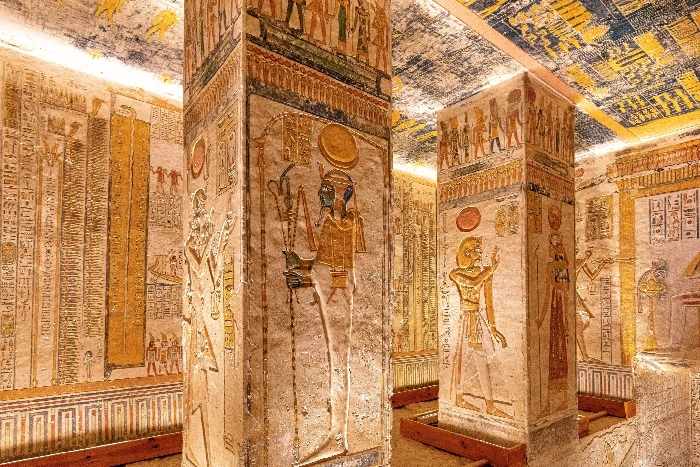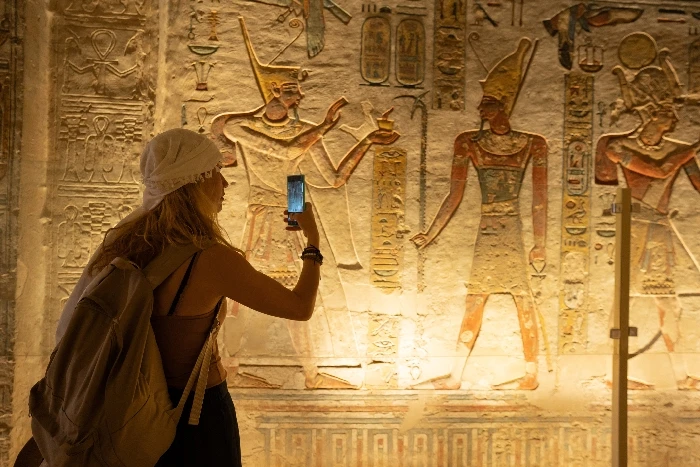Valley of the Kings: A Journey Through Egypt’s Ancient Afterlife
The Valley of the Kings, located near Luxor on the Nile’s west bank, served as the hidden burial site for Egypt’s New Kingdom pharaohs, including Tutankhamun and Ramses II. Unlike the grand pyramids, these tombs were carved into desert cliffs to protect them from looters. With 63 discovered tombs—many featuring vivid artwork and mythological scenes—the site offers a powerful glimpse into ancient beliefs about the afterlife. Despite past looting and modern challenges like floods and tourism, the valley remains a must-visit destination, especially for those seeking a deeper, more immersive experience in Egypt’s ancient history.
The Valley of the Kings: Echoes of Egypt’s Golden Age
Nestled on the west bank of the Nile, just across from what was once ancient Thebes (modern-day Luxor), the Valley of the Kings is more than just a burial site—it's a monumental chapter in Egypt's royal history. For around 500 years, from 1539 BCE to 1075 BCE, this valley served as the final resting place for pharaohs and elite members of the New Kingdom.
Why This Valley?
The Valley of the Kings wasn’t randomly placed—its location held deep spiritual and strategic meaning. To the ancient Egyptians, the west symbolized death, making the west bank of the Nile a sacred burial ground. Towering above is al-Qurn, a pyramid-shaped mountain that fit perfectly with solar and funerary beliefs.
Practical reasons mattered too. After pyramid tombs were looted, pharaohs chose this hidden valley for better protection. Its remote cliffs and soft limestone made it ideal for carving elaborate tombs while shielding them from intruders and water damage.
East vs. West: A Tale of Two Valleys
The Valley of the Kings actually consists of two sections. Most royal tombs, including the most famous ones, are found in the East Valley, which is where most tourists head. The West Valley—nicknamed the Valley of the Monkeys—is quieter and far less visited. Currently, only the tomb of Pharaoh Ay is open to the public in this more remote area.
How Many Tombs Are There?
The Valley of the Kings holds 65 tombs from Egypt’s New Kingdom, but only around 20 belonged to pharaohs. The rest were built for royals and officials. Tombs vary in size—from simple pits to vast complexes like KV5. A rotation system limits access to preserve the artwork, giving visitors a meaningful glimpse into ancient history while protecting it for future generations.

Famous Tombs in the Valley of the Kings: A Journey into Egypt’s Royal Afterlife
Tucked into the desert cliffs west of Luxor, the Valley of the Kings served as the sacred burial site for Egypt’s mighty New Kingdom pharaohs. With over 60 tombs uncovered, only a select few stand out for their historical impact, remarkable preservation, or lingering mysteries. These legendary tombs continue to intrigue travelers and historians from around the world.
1. Tomb of Tutankhamun (KV62)
The Boy King’s Hidden Legacy
Discovered in 1922 by British archaeologist Howard Carter, the tomb of Tutankhamun remains the most iconic in the Valley. Unlike most royal tombs that were looted in antiquity, KV62 was found largely intact, filled with dazzling treasures including the famous gold funerary mask. Though small and modest compared to others, the tomb’s discovery reshaped global interest in Egyptology. Visitors today can still see Tutankhamun’s mummy on display in his burial chamber, a poignant connection to a pharaoh who died young but achieved immortality.
2. Tomb of Seti I (KV17)
A Masterpiece of Ancient Art
The tomb of Seti I, one of Egypt’s most accomplished rulers and the father of Ramses II, is among the largest and most beautifully decorated in the valley. Known for its stunningly detailed wall carvings and vivid paintings depicting the king’s journey through the underworld, KV17 is a high point in Egyptian funerary art. It stretches over 137 meters into the rock and features multiple corridors, chambers, and symbolic texts from the Book of the Dead and Book of Gates.
3. Tomb of Ramses II (KV7)
The Pharaoh Who Ruled for 66 Years
Ramses II, often called Ramses the Great, is one of the most celebrated rulers in Egyptian history. His tomb, KV7, once richly decorated, suffered from centuries of flooding and decay. Though much of its original grandeur has faded, its significance remains. As the final resting place of a ruler known for massive monuments, military conquests, and diplomatic triumphs, KV7 is a key piece of the valley’s royal puzzle. Nearby, the tombs of many of his sons (like KV5) suggest a vast family burial complex.
4. Tomb of Thutmose III (KV34)
The Hidden Tomb of the Warrior King
One of the earlier tombs in the Valley, KV34 belonged to Thutmose III, often referred to as the “Napoleon of Egypt.” His tomb is perched high in a remote cliff and was among the first to adopt a winding, descending layout that became typical of later royal tombs. Inside, its walls are adorned with unusual stick-figure-style depictions of deities and texts from the Amduat—a guide through the 12 hours of the night. KV34 is a remarkable example of the transition in tomb design and religious expression.
5. Tomb of Amenhotep II (KV35)
A Royal Surprise Vault
KV35 is not only the final resting place of Amenhotep II but also became a hidden cache for several other royal mummies, reburied there by ancient priests for safekeeping. This tomb is especially significant because it housed the mummies of famous pharaohs like Thutmose IV, Seti II, and possibly even Queen Tiye. Its clever architecture, vivid art, and role in protecting royal remains make it a must-see for anyone delving into the Valley’s mysteries.
6. Tomb of Horemheb (KV57)
A Military Man’s Grand Farewell
Horemheb rose from general to pharaoh, restoring order after the chaotic Amarna Period. His tomb, KV57, reflects both innovation and traditional themes, with early versions of religious texts like the Book of Gates. Richly decorated and structurally impressive, it marks a return to conservative royal burial practices after the more experimental styles of Akhenaten’s reign.
7. Tomb of Ramses IX (KV6)
The Tourist Favorite
Located near the valley’s main path, KV6 is one of the more accessible tombs and often open to the public. Its long, straight axis and colorful decorations make it popular with visitors. Though unfinished at the time of the king’s death, it features large-scale images of gods and scenes from the Book of Caverns and Book of the Dead, providing an insightful overview of Egyptian religious thought.

Exploring the Valley Today
To protect delicate artwork, only a rotating selection of tombs is open at any given time—each offering a glimpse into centuries of evolving art, architecture, and belief. Ongoing conservation efforts ensure that every visit remains special and impactful. Many travelers also explore nearby sites like the Temple of Hatshepsut and Colossi of Memnon, often with knowledgeable guides who enrich the experience through storytelling and insight.
Inside the Tombs: A Divine Journey in Color and Stone
Tombs are richly decorated with scenes from sacred texts like the Book of the Dead and Book of Gates, guiding souls to the afterlife. Star-covered ceilings and depictions of gods like Osiris and Ra turned each chamber into a spiritual map for the deceased’s journey beyond.
Planning Your Valley of the Kings Tour
A little planning goes a long way in making your visit to the Valley of the Kings smooth and memorable.
Best Time of Year to Visit
Winter (October–April) offers the best weather. Visit early morning or late afternoon to avoid crowds, with mid-morning often quieter than expected.
Ticket Types and What They Include
General admission (around 600 EGP) covers three tombs. Special tombs like Tutankhamun, Seti I, and Ramesses V/VI require separate tickets. A tram ticket and camera pass (if needed) are sold separately.
What to Pack for Your Visit
Bring water, sunscreen, a hat, sunglasses, sturdy shoes, and light clothing. Make sure to carry enough Egyptian pounds for entry fees and other costs.
How to Visit the Valley of the Kings
Accessible by road or ferry, the site is open daily from 6:00 AM to 5:00 PM. A guide is highly recommended to help uncover the rich meaning behind the tomb art and design.

The Valley of the Kings: Gateway to Egypt’s Eternal Legacy
The Valley of the Kings isn't just about tombs—it's a powerful journey into the beliefs, art, and afterlife rituals of ancient Egypt. With 65 royal burials carved over centuries, this sacred site reveals the pharaohs' quest for immortality.
Smart planning helps avoid crowds and extra costs for special tombs like Tutankhamun’s. Lesser-known spots like Deir el-Medina and KV5 offer hidden treasures with stunning artwork.
A guided visit brings the site to life, turning stone corridors into vivid stories. For those drawn to history and mystery, the Valley offers a timeless connection to the ancient world.

Frequently Asked Questions About the Valley of the Kings
1. Where can I find the Valley of the Kings?
The Valley is located on the west bank of the Nile near Luxor, hidden among the desert cliffs. It served as the burial site for many New Kingdom pharaohs.
2. Why did the ancient Egyptians choose this specific place for royal tombs?
The west symbolized death in ancient Egyptian belief, and the pyramid-shaped peak of al-Qurn made this site both spiritually and strategically ideal for royal burials.
3. How many tombs will I find in the Valley of the Kings?
There are 65 discovered tombs. About 20 are definitively linked to pharaohs, while others belong to royal family members and high officials.
4. Can I visit the tomb of Tutankhamun?
Yes, Tutankhamun’s tomb is open to visitors with a separate ticket. Though small, it’s one of the most iconic sites in the valley.
5. Which tombs should I make sure to see?
Top choices include the tombs of Seti I, Ramses II, Thutmose III, and Amenhotep II—all famous for their scale, artwork, and preservation.
6. Are all the tombs open when I visit?
Not all at once. Tombs are rotated to protect the delicate art from damage. However, there’s always a diverse and worthwhile selection open.
7. When should I plan my visit for the best experience?
The best time is during the cooler months (October to April). Early mornings or mid-afternoons are ideal for fewer crowds and comfortable temperatures.
8. How much should I expect to pay for tickets?
General admission includes entry to three tombs, but special tombs like Tutankhamun or Seti I require separate tickets.
9. What should I bring with me to the site?
Essentials include water, sun protection, a hat, comfortable shoes, and local currency for tickets and passes.
10. Do I really need a guide to explore the Valley?
A licensed Egyptologist guide is highly recommended. Their knowledge brings the tombs’ artwork and history to life.
11. Can I take photos inside the tombs?
Photography is allowed in many tombs with the purchase of a photo pass, though restrictions vary, so it’s best to check in advance.
12. What else can I see nearby during my trip?
Nearby highlights include the Temple of Hatshepsut and the Colossi of Memnon—often visited together as part of a full-day tour or Nile cruise stop.
13. What should I pack for my visit to the Valley of the Kings?
Essential items include multiple water bottles, sun protection (hat, sunglasses, and high SPF sunscreen), comfortable walking shoes, and light, breathable clothing. Don't forget to bring sufficient cash in Egyptian pounds for tickets, tips, and unexpected expenses.
Explore the Valley of the Kings, Egypt’s iconic royal burial site, and discover its most fascinating tombs. Plan your adventure with expert Egypt travel packages and scenic Nile River cruises for a complete journey into ancient history.

Happy Travellers with Cairo Nile Cruise!
Take a look at our top Egypt Tours reviews, where you will find firsthand insights from our very own Intrepid travellers.






